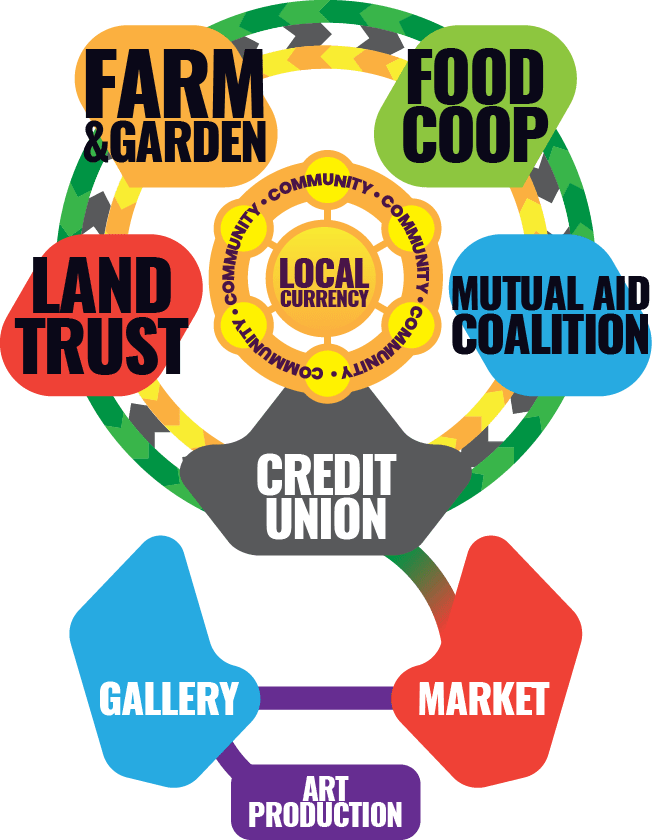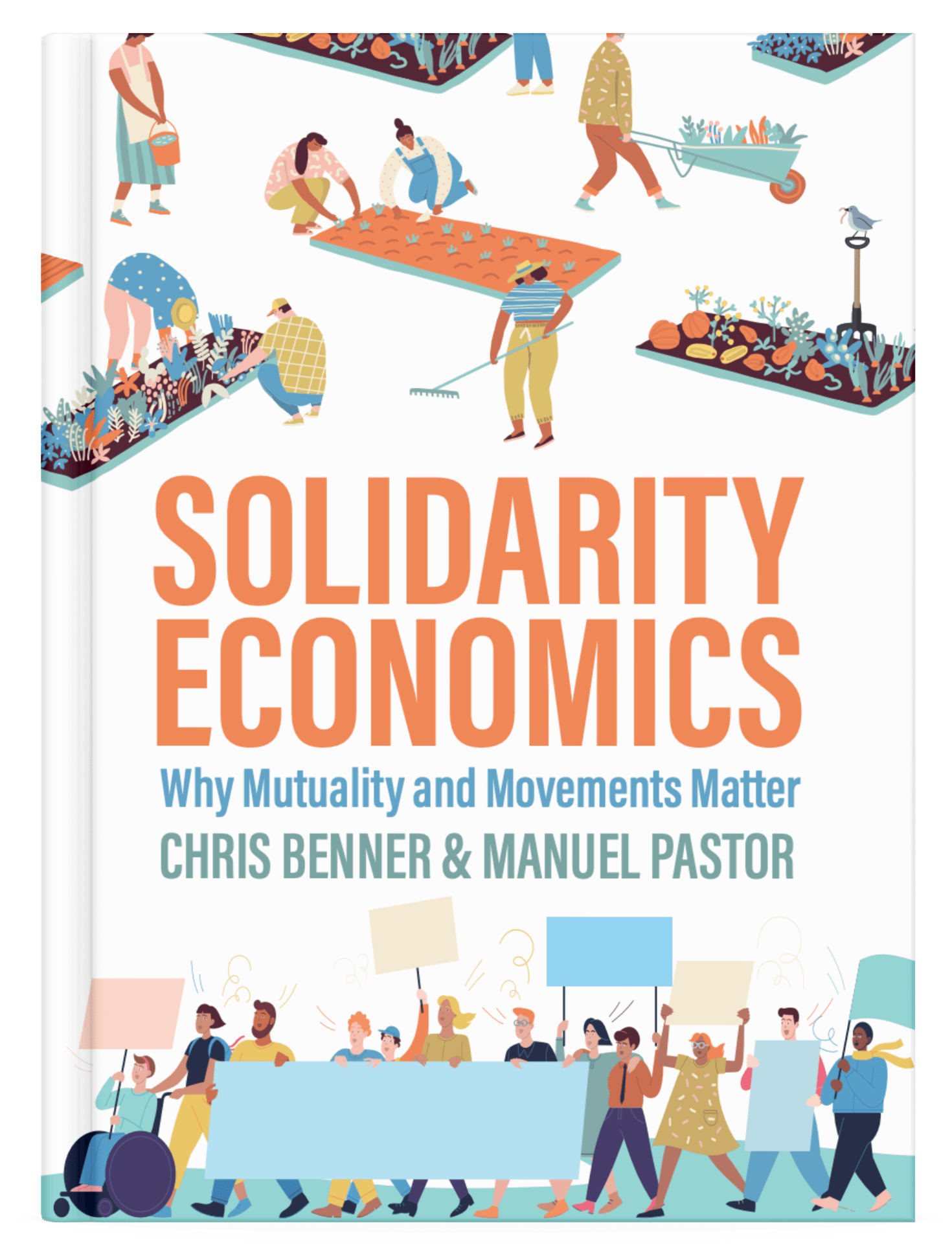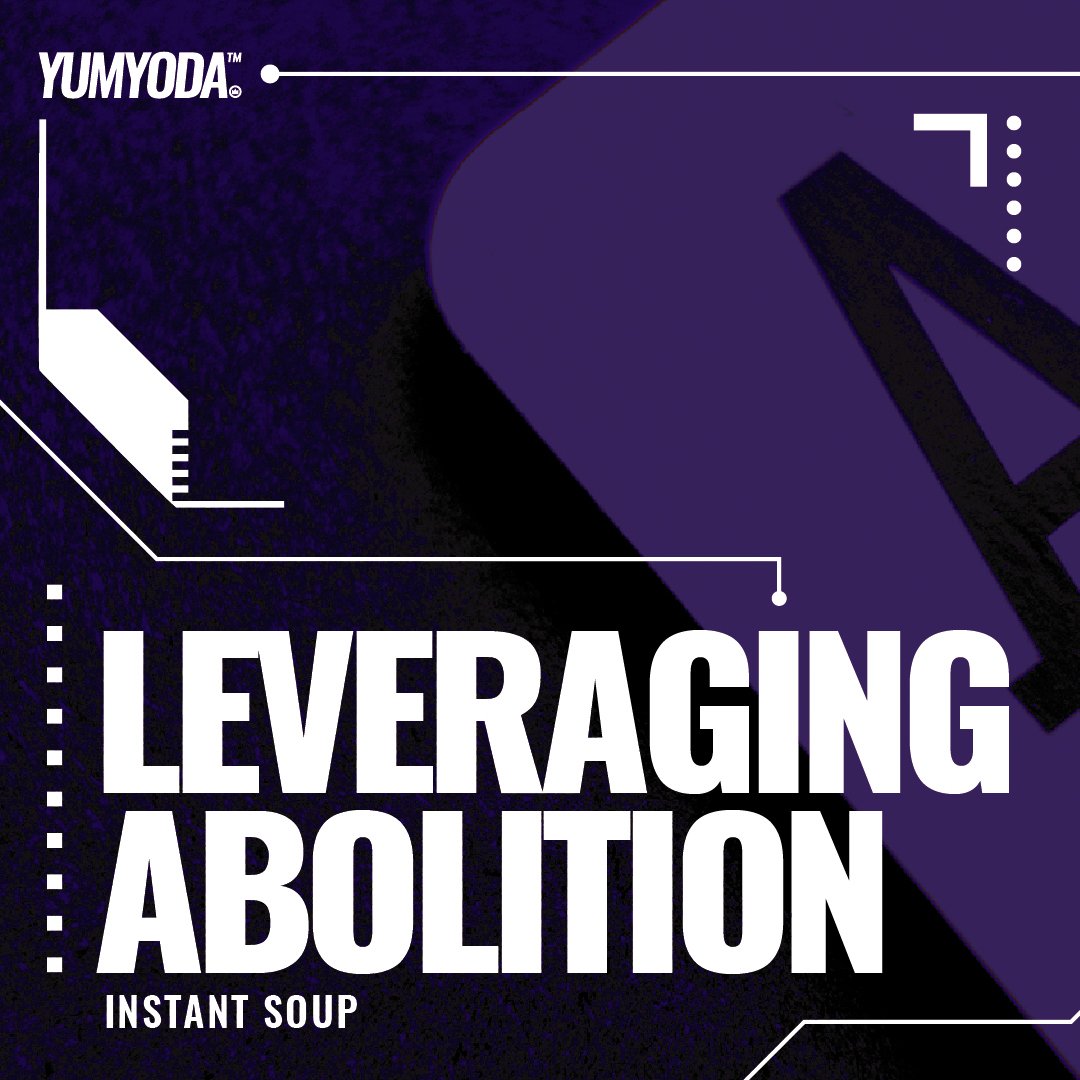In our pursuit of resistance and revolution in NYC, a shared challenge emerges: the intricate link between financial well-being and movement sustainability. Organizations, big or small, face operational hurdles often rooted in financial constraints.
Consider the metaphorical “Abolition Apples,” a group dedicated to obtaining and distributing apples. The ability to commute, pay rent, feed themselves and their families, and pursue personal goals outside of distributing apples to the community is critical to the individual’s survival and the group’s consistency. When payments are missed, job searches become stressful, and basic needs such as gas money, rent money, and money to sustain the members of the group’s essential needs go unmet, the capitalistic world’s gravitational pull grows stronger, counteracting our resistance. As a result, mutual aid groups whither away.
In acknowledging this reality and the associated pain, I propose a solution that rings in almost every discussion I’ve had—creating an alternative system. Capitalists thrive when we reject solutions, but we can break this pattern. We can establish, maintain, interact, experiment, and expand alternatives to capitalism. This solution is potent; it not only empowers individuals but also sets the stage for capitalism’s natural evolution—implosion. Not only does this system damp classism, but also circulates wealth in order to maintain the organizations initiated by the community.
This alternative is not just a concept; it is a flow. We are investigating how wealth and resources circulate within the community, forming a new and sustainable economy. This approach increases purchasing power, instills resilience, counters hierarchies and classism, all while laying the groundwork for a future where empowerment and sustainability coexist. It connects the “top” and “bottom” of the vertical enterprise, removing the existence of such perceptions.
In the current solidarity economy, financial supplementation is required, prompting organizations to seek external funding. Using another metaphor, the options in a solidarity economy are analogous to computer system components: cooperatives, credit unions, participatory budgets, CLTs, cohousing, and so on are the monitor, keyboard, mouse, router, wifi, tower, and so on. The issue is that the monitor is in one corner of the room and the keyboard is in another. It is fully functional, but disconnected. This is the current state of solidarity economics in the United States.
When we talk about circulating wealth, we want to connect these pieces and bring them all together on one table while wiring for the flow of wealth. Pressing the ‘on’ button and watching the monitor turn on are the results. We break down specific hubs in this article, not claiming exclusivity or rigid definitions but rather presenting a sketch of an idea addressing a long-standing problem.
🌟 Support the artists we showcase and discover new music 🌟

Mutual Aid and Community Services:

Role: Facilitate direct community support and services.
Objectives:
- Engage in community services (e.g., street cleaning, park management, copwatch, community defense, violence interrupters, educators).
- Establish and maintain mutual aid initiatives to support community members in times of need.
Importance: In the expansive realm of solidarity economics and interconnected local hubs, the multifaceted role of Mutual Aid and Community Services stands as a cornerstone. Here’s a nuanced exploration of their significance:
- Diverse Community Initiatives: Mutual Aid and Community Services dynamically respond to a myriad of community needs, ranging from street cleaning to educational programs to food distribution, reflecting a diverse array of initiatives that cater to the unique requirements of residents.
- Tailored Educational Initiatives: By offering tailored educational programs, these entities contribute to the holistic well-being of the community, ensuring that educational initiatives align with the specific needs and aspirations of residents outside the traditional system.
- Mutual Aid Networks: Establishing and maintaining mutual aid networks demonstrates a commitment to adaptability, with a focus on responding to emergent community needs swiftly and effectively.
- Proactive Security Measures: Active involvement in community defense initiatives contributes to a community-led approach to safety, encompassing various measures beyond traditional law enforcement.
- Promotion of Collective Responsibility: Encouraging community-led solutions sparks innovation, allowing residents to use their imagination and creativity to address challenges collectively.
- Addressing Social Injustices: Beyond community defense, Mutual Aid and Community Services engage in holistic advocacy, addressing broader social injustices and systemic issues affecting residents.
- Building Trust and Solidarity: Through impactful community services, these entities contribute to community-driven trust-building, fostering a sense of shared responsibility and solidarity.
Mutual Aid and Community Services, in essence, act as catalysts for a vibrant and resilient community. Instead of a comprehensive list, these examples are intended to spark the imagination of what mutual aid can become. We encourage you to envision and implement diverse programs that meet the specific needs and aspirations of your community. The beauty lies in the residents’ creativity and collective power to shape initiatives that reflect the essence of their community.
Social Enterprises Collective:

Role: Collaborate with local producers, farmers, and merchants.
Objectives:
- Engage in cooperative and collective initiatives.
- Support local farmers, producers, and merchants.
- Collaborate with the CLT and community initiatives.
Importance: The Social Enterprises Collective plays a pivotal role in fostering collaboration and supporting local economic initiatives within the context of solidarity economics, CLTs (Community Land Trusts), and mutual aid. Here’s an exploration of its importance:
- Collaboration with Local Producers, Farmers, and Merchants: By collaborating with local producers, farmers, and merchants, the collective creates economic synergy, fostering a network of interconnected businesses. The collective expands its product range by partnering with a variety of local entities, ensuring a diverse and vibrant marketplace.
- Engagement in Cooperative and Collective Initiatives: Social enterprises within the collective may adopt cooperative structures, promoting democratic decision-making and shared ownership among members. Initiatives that pool resources collectively enable members to share costs, risks, and benefits, creating a more resilient and supportive economic ecosystem.
- Market Access and Fair Trades: The collective provides a platform for local farmers, producers, and merchants to access a larger market, thereby contributing to their economic sustainability. The collective, which emphasizes fair trade principles, ensures that local contributors are fairly compensated for their goods and services.
- Collaboration with CLTs and Community Initiatives: By working with CLTs, the social enterprises collective can better align its efforts with community land use planning, resulting in more sustainable and community-owned spaces. Participating actively in community initiatives fosters a sense of shared responsibility and strengthens the collective’s ties to the larger community.
- Promotion of Cooperative Values: The collective promotes cooperative values, educating members and the community about the benefits of collaborative business models. By prioritizing collective success over individual gain, the collective embodies principles of mutual support and shared prosperity.
- Resilience and Adaptability: The collective, through its cooperative nature, can adapt more effectively to economic challenges, as members work together to find innovative solutions. By supporting each other, the social enterprises within the collective contribute to the overall resilience of the local economic ecosystem.
- Community Engagement and Connection: The collective prioritizes community needs, ensuring that its initiatives benefit and resonate with the local population in the most rational and responsible manner possible. The social enterprises collective strengthens the social fabric of the community through collaboration and shared initiatives, promoting a sense of belonging and interconnectedness.
In essence, the Social Enterprises Collective acts as a dynamic force within the solidarity economic framework, promoting collaboration among local businesses and contributing to the overall well-being and resilience of the community.
Community Garden & Warehouse:

Role: Manage and distribute local produce and goods.
Objectives:
- Cultivate and harvest produce for distribution.
- Expand and enhance gardening initiatives.
- Manage a community warehouse, ensuring the effective storage and distribution of goods, including essentials and raw materials.
Importance: Importance: The Community Garden & Warehouse, located at the heart of sustainable community development, is critical in providing local produce and essential goods. Its importance lies in fostering self-sufficiency, promoting environmental sustainability, and developing a resilient supply chain that meets the needs of the community.
- Cultivating and Harvesting Local Produce: The community garden contributes to local food security by cultivating fresh produce. This addresses nutritional needs and reduces dependence on external food sources. By locally growing fruits and vegetables, the community reduces its ecological footprint, promoting sustainable agricultural practices.
- Expanding and Enhancing Initiatives: Community gardens provide a platform for residents to develop not just gardening skills, but also, a wide variety of skill building and development. These platforms become the hub for fostering a sense of self-sufficiency and community resilience. Collaborating with CLTs, the community garden can contribute to the development of green spaces within community-owned lands, promoting environmental stewardship.
- Managing a Community Warehouse: The community warehouse acts as a central hub for storing locally produced goods and raw materials. This ensures efficient distribution to meet local needs. Managing a warehouse involves coordinating logistics, optimizing storage, and streamlining the distribution process, enhancing the overall effectiveness of the community’s economic ecosystem.
- Promoting Local Economies: The warehouse facilitates the exchange of local and imported produced goods, fostering economic transactions within the community. By collaborating with social enterprises such as food coops, the community garden and warehouse contribute to the success of local businesses, promoting economic sustainability.
- Community Empowerment: The community garden and warehouse represent a form of collective action, where residents work together to meet shared needs and enhance the overall quality of life. Through the management of these resources, the community gains a sense of empowerment and control over essential aspects of daily life, aligning with the principles of solidarity economics.
- Educational and Cultural Significance: Community gardens can serve as educational spaces, teaching sustainable farming practices, nutrition, and environmental stewardship. Additionally, the garden and warehouse can host cultural events, strengthening community bonds and celebrating local diversity.
In summary, the Community Garden & Warehouse act as vital components in the solidarity economic framework, contributing to local sustainability, economic resilience, and community empowerment. Their role in cultivating, managing, and distributing goods fosters a sense of self-reliance and interconnectedness within the community.
Credit Union:

Role: Facilitate financial transactions and create local currency.
Objectives:
- Facilitate financial transactions.
- Create local dollars to support community initiatives.
- Collaborate with the CLT and the artistic committee.
Importance: The Credit Union serves as a financial crux in the intricate web of solidarity economics, seamlessly facilitating transactions while pioneering the creation of local currency. Its significance extends beyond traditional banking to empowering community initiatives, collaborating with CLTs, and contributing to the vibrant cultural landscape through partnerships with the Artistic Committee.
- Facilitating Financial Transactions: Credit unions operate as member-owned financial institutions, fostering a community-centric approach to banking. They provide accessible and inclusive financial services, offering opportunities for savings, loans, and other essential banking functions to individuals who might be underserved by traditional banks.
- Creating Local Currency: Credit unions can play a pivotal role in the creation and management of local currencies. These local dollars serve as a means of exchange within the community, promoting economic transactions that specifically support local businesses and initiatives.
- Collaboration with CLTs and Artistic Committees: Collaboration with CLTs and Artistic Committees: Credit unions can finance community-owned land and housing projects with CLTs, empowering residents to manage. While physical art remains local, artists sell digital copies. Credit unions and artists split royalties. The credit union gives local currency to the CLT for Mutual Aid. Local artists benefit from this cultural enrichment and economic opportunity.
- Promoting Solidarity Economics: Credit unions inherently align with the principles of solidarity economics by prioritizing community well-being over profit maximization. The democratic governance structure of credit unions, where members have a say in decision-making, reflects the principles of solidarity and cooperation.
- Building Trust and Empowering Communities: Credit unions build trust within the community through their cooperative and member-driven model, fostering a sense of ownership and responsibility. By actively engaging with mutual aid networks, CLTs, and social enterprises, credit unions empower local initiatives that address the community’s unique needs.
In summary, the importance of a credit union in this interconnected ecosystem lies in its ability to be a financial hub that not only meets the traditional banking needs of the community but actively participates in the creation of alternative, community-driven economic systems.
Community Land Trusts (CLT):

Role: Facilitate land and resource management for community development.
Objectives:
- Obtain and invest in land and machinery for production.
- Facilitate the expansion and optimization of community resources.
- Receive funds from the cycle for investments.
Importance: The role of Community Land Trusts (CLTs) is pivotal. As facilitators of land and resource management for community development, CLTs contribute to the collective well-being and sustainable growth of the community. Here’s an exploration of their significance:
- Land and Resource Management: CLTs actively obtain and invest in land and machinery for production (although machinery purchases may occur at the cooperative level), strategically choosing investments that align with community needs and aspirations. By facilitating the expansion and optimization of community resources, CLTs ensure that these assets are utilized in ways that benefit the entire community.
- Financial Sustainability: CLTs operate within a cyclic system, receiving funds generated through community initiatives for further investments. This cyclical flow enhances the financial sustainability of community-owned resources.
- Empowerment Through Ownership: CLTs empower the community by collectively owning and governing essential resources. This democratic approach ensures that decisions about land and technology use align with the community’s vision.
- Community-Driven Development: CLTs prioritize investments based on community needs, thereby contributing to the development of infrastructure and technological capabilities that improve overall community well-being. This initiative diverts resources from preditorial systems in order to drive down prices and expand public and community usage.
- Boosting Productive Capacity: By investing in machinery and technology, CLTs contribute to boosting the productive capacity of local initiatives, fostering economic resilience and self-sufficiency.
- Alignment with Solidarity Economics: CLTs inherently align with the principles of solidarity economics, placing community welfare at the forefront of their initiatives. This alignment strengthens the interconnected network of local hubs within the community.
- Collaboration with Credit Unions: By collaborating with credit unions, CLTs can secure financing for community-owned land and housing initiatives, ensuring that these essential resources remain in the hands of the community.
- Environmental Stewardship: CLTs promote environmentally sustainable practices in land and resource management, contributing to the community’s resilience in the face of environmental challenges.
In essence, Community Land Trusts play a vital role in the community’s economic and environmental landscape. Through strategic investments and collaborative efforts, they contribute to a resilient, self-sufficient, and community-driven approach to development.

Curator/Artistic Committee:
Role: Promote and manage artistic contributions for community fundraising.
Objectives:
- Curate and promote local artwork.
- Collaborate with artists for community fundraising.
- Ensure diverse artistic contributions.
Importance: The Curator/Artistic Committee emerges as a dynamic force in the tapestry of solidarity economics and community development, promoting and managing artistic contributions for community fundraising. Here’s an examination of their significance:
- Curation of Local Artwork: The committee curates a diverse range of local artwork, ensuring that the community’s rich tapestry of artistic expressions is represented. This diversity adds vibrancy to community initiatives.
- Promotion for Fundraising: Collaborating with artists, the committee strategically promotes artistic contributions to support community fundraising initiatives. This elevates the profile of local artists while contributing to community financial sustainability.
- Community Engagement Through Art: By curating and promoting local artwork, including visual arts, music, and more, the committee enriches the cultural landscape of the community. This engagement fosters a sense of pride and connection among residents.
- Integrated Fundraising: The committee collaborates with various community initiatives, ensuring that artistic contributions are seamlessly integrated into broader fundraising efforts. This synergy enhances the overall impact of community-driven projects.
- Nurturing Talent: The committee plays a vital role in supporting emerging artists, providing them with opportunities to showcase their work and contribute to community development. This nurturing approach fosters a thriving local artistic community.
- Art as a Catalyst for Change: The committee recognizes the power of art as a catalyst for social change. Artistic expressions are not just about aesthetics but also serve as a medium for conveying messages, advocating for causes, and sparking community dialogue.
- Building a Cultural Identity: The committee helps to build a distinct cultural identity for the community through artistic curation. This story becomes a source of pride and resilience for the characters.
In summary, the Curator/Artistic Committee plays a crucial role in shaping the cultural and financial landscape of the community. By curating, promoting, and strategically integrating artistic contributions, the committee contributes to a vibrant, culturally rich, and financially sustainable community.
Traditional economics is built on the assumption of self-interested individuals seeking to maximize personal gain, but that is far from the whole story. Sharing, caring, and a desire to uphold the collective good are also powerful motives. In a world wracked by inequality, social divisions, and ecological destruction, can we build an alternative economics based on cooperation?
Currency
- Currency Input:
- USD Inflows: External financial transactions occur, bringing in United States Dollars (USD). Rather, through donations, the social enterprise collective, or art.
- Financial Facilitation:
- Credit Union: Serves as the financial center, facilitating transactions and issuing Local Dollars as needed. Art sales are the only way to generate local funds. This creates a manageable environment because art prices vary while local currency is in circulation.
- Local Dollar Creation:
- Credit Union: Based on the USD influx from art sales, the credit union creates Local Dollars, a community-specific currency. This step ensures that financial transactions within the community stay within the community. Investors can choose between a physical and digital copy; the digital copy can be resold and may increase the value of local currency in circulation. The artist and initiatives have agreed to split royalties.
- Distribution of Local Dollars:
- Credit Union: As a priority, it directs local dollars to Community Land Trusts (CLTs), supporting Solidarity Economy projects and organizations. This deliberate focus on CLTs may appear to be selective, but it is critical for establishing a clear path of wealth circulation. By ensuring that local dollars flow through CLTs, we build a foundation for growth and efficiency. It’s important to note that this approach isn’t gatekeeping; rather, it provides a strategic overview of how local dollars work, laying the groundwork for future systems like new cash registers. This methodology aims to maximize positive community impact while avoiding fragmentation in the early stages of our fledgling system.
- Local Dollar Exchange for USD (Optional):
- CLT: When making external investments, such as acquiring new assets, CLT has the option of exchanging Local Dollars for USD. This step enables CLTs to function effectively in the larger market. Because local dollars are being temporarily removed from circulation in exchange for dollars, the value of local dollars in circulation is less likely to be affected.
- Community Initiatives:
- Mutual Aid and Community Services, Social Enterprises Collective, Community Garden & Warehouse, CLT, Curator/Artistic Committee: All of these organizations will receive Local Dollars for their respective roles and contributions to community well-being. Understanding the significance of circulating local dollars can potentially relieve hording while encouraging economic engagement in a variety of ways as financial stability improves.
- Recirculation:
- Mutual Aid and Community Services, Social Enterprises Collective, Community Garden & Warehouse, CLT, Curator/Artistic Committee: Use Local Dollars within the community to create a recirculation effect that strengthens economic resilience. When logistical and creative endeavors realign with community-based goals, this occurs.
- External USD Transactions:
- Social Enterprises Collective: As a cooperative, Social Enterprises Collective engages in external transactions that may result in additional USD, ensuring a link to the larger economy while focusing on local sustainability. These businesses, which include artists, merchants, and cooperatives, make significant contributions to our economic model by opening locations that accept both American and local currency.









